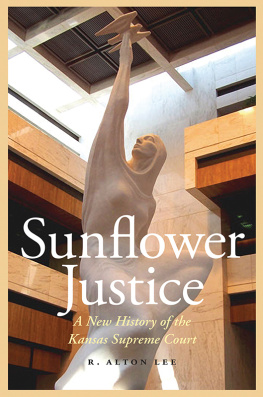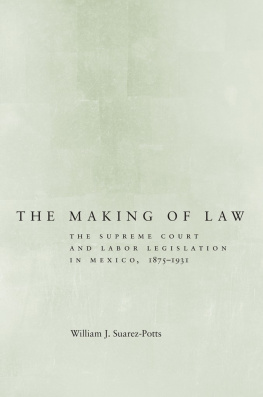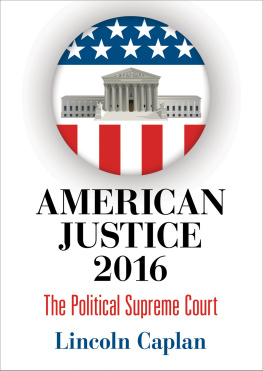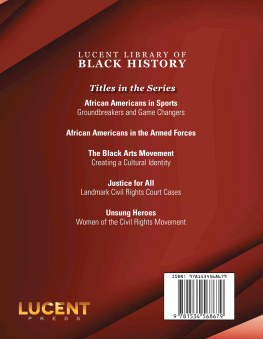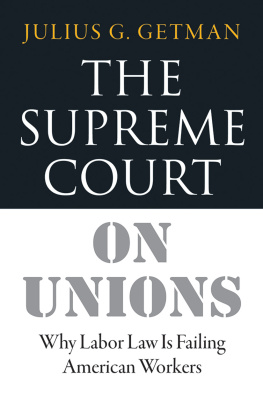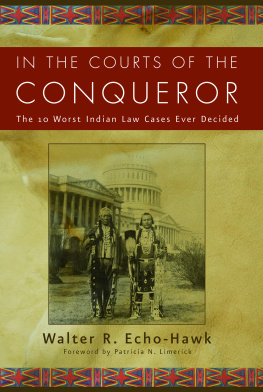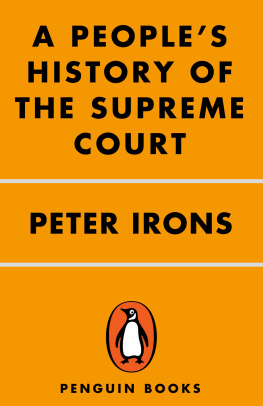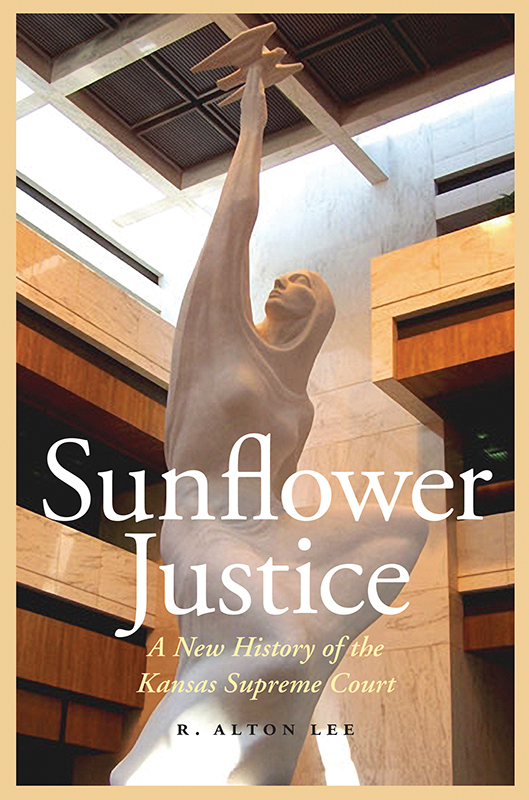
Sunflower Justice demonstrates that the Kansas Supreme Court decided important cases involving unions, prohibition, contracts, and school segregation that were appealed to the U.S. Supreme Court. The state high court was in the vanguard in several policy areas, especially during the Progressive period and era of prohibition. The book is a major contribution to the study of state supreme court history.
John A. Fliter, coauthor of Fighting Foreclosure: The Blaisdell Case, the Contract Clause, and the Great Depression
Sunflower Justice
Law in the American West
Series Editor
John R. Wunder, University of NebraskaLincoln
Sunflower Justice
A New History of the Kansas Supreme Court
R. Alton Lee
University of Nebraska Press
Lincoln and London
2014 by the Board of Regents of the University of Nebraska
Jacket photo courtesy of the Kansas Office of Judicial Administration.
Author photo courtesy the University of South Dakota.
All rights reserved
Library of Congress Cataloging-in-Publication Data
Lee, R. Alton.
Sunflower justice: a new history of the Kansas Supreme Court / R. Alton Lee.
pages cm. (Law in the American West)
Includes bibliographical references and index.
ISBN 978-0-8032-4841-0 (cloth: alk. paper)
ISBN 978-0-8032-5411-4 (epub)
ISBN 978-0-8032-5412-1 (mobi)
ISBN 978-0-8032-5410-7 (pdf)
1. Kansas. Supreme Court History. 2. Courts of last resort Kansas History.
I. Title.
KFK 512. L 44 2014
347.781'035dc23
2013036676
The publisher does not have any control over and does not assume any responsibility for author or third-party websites or their content.
For Marilyn
Who made innumerable trips to the History Center in Topeka during the last decade. I cannot find the words to express my appreciation for her support of my research but she knows.
Contents
List of Illustrations
Preface
State and local legal history in the nineteenth century was neglected in part because historians do not have the legal skills to read and to interpret technical documents and complicated legal jargon. One can study the relationship to economic forces or the concept of legal thought or an aspect of group activity, but the rigors of the historical process subject the aspects of these disciplines and others to its peculiar demands. As a result, only the histories of the high courts in Florida, Massachusetts, Missouri, Tennessee, Virginia, Nebraska, and Washington have been written, although other similar studies are now under way. This is unfortunate, because it is here that the the meaningful, everyday judicial opinions are dispensed.
Michael H. Hoeflick asserts that the work that has been produced [in Kansas] primarily has been written by lawyers writing for other lawyers, and he justly laments the fact that much of the sources for writing this study have been destroyed or lost. His observations apply only
The great twentieth-century legal scholar James Willard Hurst encouraged his students to understand how the law has really worked in social experience. Yet another scholar has stressed the point that legal historians have insisted on a radical separation between law and politics. I reject this latter distinction and support Hursts injunction because this subject is a specialized form of political history. Politicians shape the law and use it for whatever type of social and economic policies their constituents want their government to pursue. Judges are citizens with their own political, social, and economic predilections, and these often, consciously or subconsciously, influence the writing of their decisions.
From the territorial period to 1990, the supreme court produced 245 volumes of opinions. Each volume contains approximately 250 decisions. How does the historian master such productivity? How does one organize and illuminate this mass of legal thought and development? How can the major trends be condensed so that an author can write, and readers can absorb, with any confidence of comprehension? There are many approaches, of course, and everyone who researches state supreme court histories will follow a different scheme. I have elected to choose the cases that best demonstrate the historical, social, legal, political, and economic trends of the period covered in each chapter.
Alexis de Tocqueville paid scant attention to the role political parties played in selecting American judges, but from the beginnings political parties were crucial in the Kansas system of popular election. A half century after Tocqueville wrote, Lord Bryce believed this system of selection of justices, nominally by popular election, practiced by the party of wirepullers, often kept the most honorable men from reaching the bench. This led, in the Kansas experience, to judges having to kiss babies and nail an inordinate number of posters to telephone poles during the campaign process and frequently continuing their political careers from the states highest bench. This process finally culminated in a demand in the 1950s to change the system of selecting judges to follow the principles of the Missouri Plan, which established a nonpartisan commission of lawyers and laymen to propose names to the governor for appointment to the bench. They would subsequently stand for retention on a nonpartisan ballot.
In studying the Kansas Supreme Court I decided first to consider the judges and the experiences that shaped their thinking. I then examined the decisions that molded Kansas law in the first century and a half of the courts existence. My examination focuses on both how the judges shaped legal history and how the cases they heard constituted a part of the political, economic, social, and legal story of the Sunflower State. Each chapter is introduced by a brief historical survey to set the scene for the era. Some biographical material on the judges follows, with a presentation of pertinent cases of the period. The historical background is vital not only because it was within this context that the judges shaped Kansas law but also because the political process involved them directly, as they were nominated by political parties, campaigned for elective office, and sometimes continued partisan activities while on the bench until the mid-twentieth century.
I am indebted to many people for their assistance in researching and writing this volume. Foremost are the staff of the History Center at the Kansas State Historical Society. Charles Warnica and Antoinette Satterfield of the Government Documents Division, Hale Library at Kansas State University, were of great assistance. The Manhattan Public Library was an important source for interlibrary loan. Ramon Powers has been highly supportive of my efforts in writing Kansas history. At his suggestion I contacted retired Justice Fred N. Six in the early stages of this study. He kindly gave me advice, based on his experience and interest in legal history, that greatly improved my approach. After the study was finished, he generously spent time reading the entire manuscript and offering many pertinent suggestions for improvement. I must also credit him with the title, although I acknowledge that the subtitle is mine. Professor Derek Hoff of Kansas State University took time from his busy schedule and read part of the manuscript, suggesting changes in format and organization for which I am grateful.
Of course, I cannot hold these scholars accountable for my decision to decline some of their suggestions, many of which might have made the study stronger.
Sunflower Justice
Introduction
Ad Astra per Aspera
To the stars through difficulties. Kansas was enduring Herculean challenges, even agony in some cases, in its first few years of existence as a territory. Although it suffered a shorter tenure as a territory than any of its surrounding neighbors, those seven years were tumultuous indeed. But the New England Emigrant Aid Company stocked the territory with sound settlers who knew how to endure adversity, and its citizens survived both the buffeting of Mother Nature and the battering of hostile neighbors.
Next page
